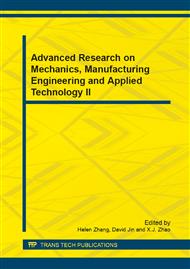[1]
Toering, TYNKE; JORDET, GEIR; RIPEGUTU, ANDERS. Effective learning among elite football players: The development of a football-specific self-regulated learning questionnaire. Journal of Sports Sciences. Oct2013, Vol. 31 Issue 13, pp.1412-1420.
DOI: 10.1080/02640414.2013.792949
Google Scholar
[2]
2., Jesse A.; Rutkowski, Leslie A.; Vaughan, Ellen L.; Steinfeldt, Matthew C. Masculinity, Moral Atmosphere, and Moral Functioning of High School Football Players. Journal of Sport & Exercise Psychology. Apr2011, Vol. 33 Issue 2, pp.215-234.
DOI: 10.1123/jsep.33.2.215
Google Scholar
[3]
Rhea, Matthew R.; Hunter, Randy L.; Hunter, Tad J., COMPETITION MODELING OF AMERICAN FOOTBALL: OBSERVATIONAL DATA AND IMPLICATIONS FOR HIGH SCHOOL, COLLEGIATE, AND PROFESSIONAL PLAYER CONDITIONING. Journal of Strength & Conditioning Research Feb2006, Vol. 20 Issue 1, p.58.
DOI: 10.1519/00124278-200602000-00010
Google Scholar
[4]
Kristiansen, E.; Halvari, H.; Roberts, G. C., Organizational and media stress among professional football players: testing an achievement goal theory model. Scandinavian Journal of Medicine & Science in Sports Aug 2012, Vol. 22 Issue 4, p.569.
DOI: 10.1111/j.1600-0838.2010.01259.x
Google Scholar
[5]
Nobuyoshi Hirotsu; Masamitsu Ito; Chikara Miyaji; Koji Hamano; Azuma Taguchi, Modeling Tactical Changes of Formation in Association Football as a Non-Zero-Sum Game. Journal of Quantitative Analysis in Sports Jul 2009, Vol. 5 Issue 3, p.1138.
DOI: 10.2202/1559-0410.1138
Google Scholar
[6]
Kristensen, L. B.; Andersen, T. Bull; Sørensen, H., Optimizing Segmental Movement in the Jumping Header in Soccer. Sports Biomechanics Jul 2004, Vol. 3 Issue 2, p.195.
DOI: 10.1080/14763140408522840
Google Scholar
[7]
Tierney, Ryan T.; Higgins, Michael; Caswell, Shane V.; Brady, Jessica; McHard, Krista; Driban, Jeffrey B.; Darvish, Kurosh, Sex Differences in Head Acceleration During Heading While Wearing Soccer Headgear. Journal of Athletic Training Nov/Dec2008, Vol. 43 Issue 6, p.578.
DOI: 10.4085/1062-6050-43.6.578
Google Scholar
[8]
Kontos, Anthony P.; Dolese, Angela; Elbin III, R. J.; Covassin, Tracey; Warren, Barbara L. Relationship of soccer heading to computerized neurocognitive performance and symptoms among female and male youth soccer players. Brain Injury. Nov2011, Vol. 25 Issue 12, pp.1234-1241.
DOI: 10.3109/02699052.2011.608209
Google Scholar
[9]
Andersson, Helena; Ekblom, Björn; Krustrup, Peter, Elite football on artificial turf versus natural grass: Movement patterns, technical standards, and player impressions. Journal of Sports Sciences Jan2008, Vol. 26 Issue 2, p.113.
DOI: 10.1080/02640410701422076
Google Scholar


